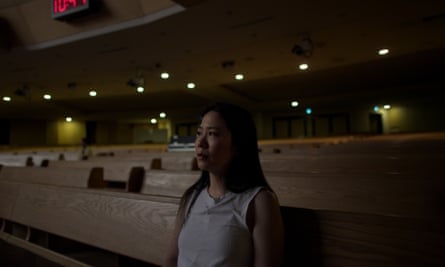Since they were young girls, Miranda and Melanie Wilking danced together. The sisters, two years apart, grew up exceptionally close in suburban Detroit, dancing in their basement, in competitions and eventually in pursuit of a professional career. When Miranda graduated high school and moved to Los Angeles to chase the dream, Melanie followed as soon as she could. The duo, who looked nearly identical – long brown hair, bright blue eyes, sharp features, deep tans and lithe physiques – found modest work auditioning together, but greater success online. By this point, in the late 2010s, TikTok was on the rise; short, peppy dance videos to a front-facing camera were the fastest avenue to a following, and thus a living, via sponsorships. Miranda and Melanie started an account together as the Wilking Sisters; by 2020, they had over 3 million followers on the platform.
But in 2021, the sisters suddenly stopped posting new videos together, as things fell apart behind the scenes. Through her boyfriend James “BDash” Derrick, a dancer well-known for the LA-based street-style krump, Miranda and several dancer friends had joined a management company called 7M as well as its affiliate Christian church, Shekinah, both run by a man named Robert Shinn. Melanie always followed her older sister, but was put off by Shinn’s “weird” messianic vibe and the pressure to attend services. Soon Miranda began acting strangely, distancing herself from her formerly close family and anyone not associated with 7M. She chopped her hair short, dyed it blonde, and started new social channels, posting dance videos that followed a distinct 7M template: punchy, polished, slightly hypnotic, with aspirational backdrops – expansive patios, mansions, Hollywood landmarks. By January 2021, she cut off contact with her family entirely. Though Miranda was posting frequently to social media, to those that knew her, she wasn’t Miranda any more. “I literally feel like my sister died. She’s everywhere, but nowhere,” Melanie explains in the new Netflix docu-series Dancing for the Devil: The 7M TikTok Cult.
The three-part series begins in February 2022, when Melanie and her parents, Dean and Kelly Wilking, went public with their concerns on Instagram Live. It was Miranda’s 25th birthday, and they hadn’t spoken to her in over a year. The Wilkings used the word “cult” to describe 7M and Shinn’s church, and asked the public for help. The internet, always primed for a new cult scandal, took up the cause, especially given 7M’s relative ubiquity; several dancers had follower counts in the millions. While Miranda and Derrick, by then married, insisted publicly that they were fine and not in a religious cult – Miranda posted several eerie live videos to stress the point – online sleuths began to dig into Shinn’s past, issue explainers and close-read 7M dancers’ videos for signs of distress. Meanwhile, the Wilkings agreed to be part of a documentary capturing their efforts to, as they put it, free Miranda and expose Shinn’s psychological manipulation.
Dancing for the Devil is partly that, and partly a testimony of processing; the series shifted as some dancers left 7M during filming and, along with some former Shekinah congregants, agreed to speak publicly about their past, their deprogramming and their decision to pursue legal action against Shinn. “The perception … is that once you’re out, you’re so excited to get back to your family and resume a normal life, so to speak,” said series director Derek Doneen. “And as soon as we started spending time with the subjects in this show, you realize that it is just day one of a whole new journey of healing.”
In its real-time footage of efforts to expose a cult and hold its leader accountable, Dancing for the Devil recalls the 2020 HBO docuseries The Vow, on the sex cult Nxivm, one of several series in recent years on cult-like psychological manipulation. Dancing for the Devil is a knowing participant of the true-crime subgenre. “There are a lot of deeply compelling cult documentaries out there,” said Doneen. “That said, we also didn’t want to make the same show that [audiences] have already seen. It’s really important for us to approach it from a different perspective, one that places the victims and the families at the center of it and allows them to tell their own story, in their own words, in a way that doesn’t make it about the cult leader.”

Shinn, who declined to participate in the series, is not absent from it. Dancing for the Devil details Shinn’s alleged emotional, financial and sexual abuse: according to former 7M dancers and Shekinah members, as well as audio recordings of his sermons, Shinn referred to himself as the “man of God”, solely capable of saving members from hell. He instructed followers to “die to yourself” – sever contact from loved ones to humble and save oneself, and by extension them, from eternal damnation. Shinn stressed that “your thoughts are not your own” – they’re either from the devil or from God – and must always be reported to a higher-ranking mentor. Those he deemed disappointments were singled out and belittled during worship. He demanded members give most of their money as church tithing and, according to former members, would remove more from their bank accounts for “church purposes”. He long dreamed of Hollywood success and fame, handily and speedily provided by viral dance videos.
But the series does not dwell on his biography or theorize possible psychological motivations. “Of course, you need to know about Robert [Shinn],” said Doreen. “You need to know who he is and the way that he works and how he manipulates and controls his members. But we really wanted this show to be more from the experience of the families – what does it feel like to lose somebody you love into a situation like this? What does it feel like, then, to escape?”
Those questions are lived by Melanie and Priscylla Lee, sisters who fell under Shinn’s influence nearly two decades before Miranda Wilking did. Korean immigrants to LA with absent parents, the Lee sisters were poor, lonely and isolated. Melanie was the first to join Shekinah, which at the time predominantly served fellow Korean immigrants, as a young teenager in 2001. Priscylla was older, the provider, but “my sister was my weak spot”, she recalls, so she joined, too. The two lived together in a house with other Shekinah members, until the church forced them to separate. Both sisters claim they experienced regular and repeated sexual assaults by Shinn. Melanie escaped with the help of a high-school friend in 2011, unable to bring her sister with her. Priscylla remained, isolated and separated from Melanie, for another decade.

The series captures the sisters’ stilted, furious attempts to reconnect – some of the most moving and heartbreaking footage I’ve seen in a cult documentary – as well as Priscylla’s journey toward a lawsuit and police report naming Shinn. The film-makers stressed that those scenes, involving people whose understanding of themselves and their situation changes by the day, were the result of months of off-camera conversations and trust-building. Filming was done with as small a crew as possible, often just three people – Doneen, executive producer Jessica Acevedo and a sound person. Participants could pull the plug at any point. “Continuing that safe space after the camera stopped rolling and creating that open door for conversation hasn’t stopped,” said Acevedo. “This isn’t just a job. This is people’s real lives, and it’s not just making a documentary. It’s handling how people are navigating something very serious and traumatic in this next chapter of their life.”
That next chapter, former dancers and members hope, will include consequences for Shinn, who as of now has not been formally accused of any crimes. As the Rolling Stone reporter Andrew Marks notes in the series, it’s not illegal to run a cult. At least three women, including Priscylla Lee, have reported a sexual assault by Shinn to the police, but he has not been arrested. Could the Netflix show lead to legal recourse? “We’ve seen it before,” said Doneen. “Our job as film-makers is just to start the conversation. We’re not legislators. But what we can do is put something out there that gets a lot of people talking, that starts a conversation, that ignites a debate and, hopefully, could potentially bring about meaningful change.”
The series ends without conclusion; 7M continues to produce dance videos, including from Miranda and Derrick, who remain affiliated, at least at series end. A week before the series airs, Miranda Derrick posted a new dance video a day, including one of a Chicago’s All That Jazz credited to Shinn’s son Isaiah. Her dance is taut, a bit frenetic, her smile as bright as the mock stage lights. Her caption reads: “Who wants Part II?”
-
Dancing for the Devil is out on Netflix on 29 May
Source: theguardian.com

